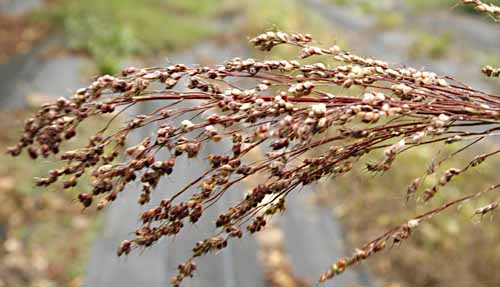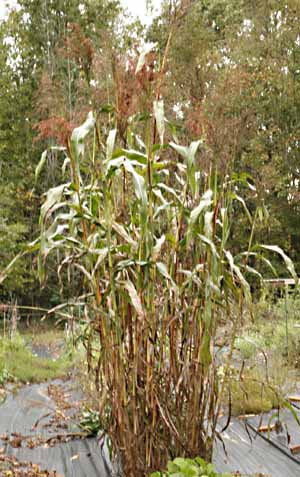Very tall grass up to 15 feet tall in one year. This annual makes an interesting temporary hedge plant or back border topped by earth tone seed heads of edible seeds. Can be left as wild bird food or eaten. Seed heads themselves are used to make brooms, hence the name. Very easy to grow with little or no maintenance makes an interesting conversation piece.
Description
Broom corn is not really a corn at all but a type of sorghum which is a grain
crop plant. Some of the worlds most important grains come from this group of
plants.
The plant is called broom corn because it is a grass that looks very much like
corn when it grows but does not produce corn ears but a tuft of grains at the
top of the plant.
Broom corn can grow up to 15 feet high and produces strong woody stalks with
a dry internal pith. The leaves are long and relatively narrow, very similar
to corn but not as prolific. The flowers are produced at the top of the plant
in a fluffy spike that is wind pollinated. They are followed by seeds that can
be either dark brown, tan, reddish, golden, cream or almost black. The tough
fibers to which they are attached are used to make excellent brooms.
Location and care
Broom corn can grow in most soil types but it needs to be well worked before
the seed is planted. Adding some compost or other organic material to the soil
will ensure a good crop. It is a very hardy plant and once planted needs little
care or maintenance. It needs full sun and may need a little watering in times
or drought or long periods without rain, otherwise no other watering is required.
Since the plants are wind pollinated they need to be grown in blocks or clumps.
Do not space the plants out individually or you will get no seeds.
Broom corn can grow to 15 feet tall so ensure that you have sufficient space
to grow it. It grows very rapidly and can make an excellent summer hedge or
privacy screen. Sow at least four rows deep to achieve sufficient leaf cover
for a hedge. Makes a great talking point.
Once planted broom corn needs little maintenance or care until harvest time.
Alternatively the plants can be left as wild bird food and bring winter entertainment
to the home.
Growing.
Seeds are relatively large so it is best to plant them directly into the ground.
Space seeds about 12" apart with the same distance between rows. Plant
about 1" deep. If planting a hedge the distance can be reduced 9"
but no more. Rows can be as much as 24" apart but do not space too wide
as the plants are wind pollinated and need to be close or there will be no seeds.
At least four rows are needed to produce good seed. Seeds can be planted closer
and thinned if desired.
Seed should be sown at least two weeks after the last frost. This will vary
greatly from area to area. If in doubt watch to see when the farmers plant their
corn and then plant your broom corn. Native Americans who used nature queues
to determine when to plant state that corn should be planted ' when oak leaves
are the size of a squirrels ear'. Oak leaves grow fast at this time so you need
to be really quick.
Germination usually take about 10 days depending on your location, temperatures
and rainfall. Plants grow fast and mature in about 15 weeks.
Broom corn can be started indoors in individual pots if desired. Grow as with
any other plant, harden off and plant out after frost has passed. Since the
plant grows so well without indoor starting it is not really necessary.
Harvesting.
Harvesting will depend on what you want. If you are looking to make a broom
then Harvesting needs to occur when the entire brush is green. If it is harvested
to early, i.e. while the lower ends are still yellow the bottom fibers will
be weak. Likewise, if left too long the
brush will begin to turn a red color
and become less flexible.
Gather into bunches and hand upside down to dry or place in a container to produce
a arched shaped as they dry.
Uses
Making brooms obviously. It takes about 60 plant tops to make one broom.
The seed heads are also used as a dried flower for making wreathes, flower displays
and all kinds of craft projects. Seed heads can be quite heavy to plan your
crafts accordingly. Often wreaths are made and hung out as wild bird food. The
strong stems can be used as stakes or made into wattle fences.
Edible uses.
The seeds are edible and can be sprouted, cooked, popped, or ground into flour.







